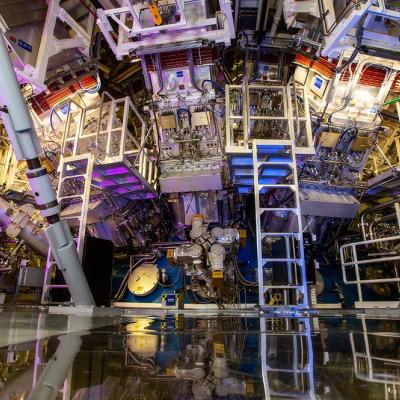LLNL researchers have developed a method to enhance the performance of polyelectrolyte membranes by using a humidity-controlled crosslinking process which can be applied to precisely adjust the water channels of the membrane.
Keywords
- Show all (56)
- Electric Grid (8)
- Carbon Utilization (6)
- Compact Space Telescopes (5)
- Diode Lasers (4)
- Laser Materials Processing (4)
- Optical Damage Mitigation (3)
- Precision Optical Finishing (3)
- RF Photonics (3)
- 3D Printing (2)
- Additive Manufacturing (2)
- Direct Air Capture (2)
- Power Electronics (2)
- Synthesis and Processing (2)
- Additively Manufactured (AM) Optics (1)
- Geologic Storage (1)
- Inertial Fusion Energy (IFE) (1)
- Manufacturing Simulation (1)
- Precision Engineering (1)
- Ultrashort Pulse Lasers (1)
- (-) Materials for Energy Products (4)

CMI—a DOE Energy Innovation Hub—is a public/private partnership led by the Ames Laboratory that brings together the best and brightest research minds from universities, national laboratories (including LLNL), and the private sector to find innovative technology solutions to make better use of materials critical to the success of clean energy technologies as well as develop resilient and secure…

This novel detector for characterizing IFE implosions is an alternative to the current RTNADs to measure neutron fluxes > 3x1011 neutrons/cm2 at high shot rates. The detector consists of a stack of small square metal wafers separated by thin insulating spacers. Every other wafer is held at high voltage while the remaining wafers are grounded. The stack acts as an…

LLNL researchers have developed a new 3D printable lithium-air battery that uses a novel thin solid state ceramic electrolyte. LLNL’s invention overcomes the combined challenges of low power density and low cycle life in previously designed lithium-air batteries by using solid state electrolytes to achieve stability and multiscale structuring of the electrolyte to achieve low interfacial…

Nanomaterials that are emerging out of cutting edge nanotechnology research are a key component for an energy revolution. Carbon-based nanomaterials are ushering in the "new carbon age" with carbon nanotubes, nanoporous carbons, and graphene nanosheets that will prove necessary to provide sustainable energy applications that lessen our dependence on fossil fuels.
Carbon aerogels (CAs)…

